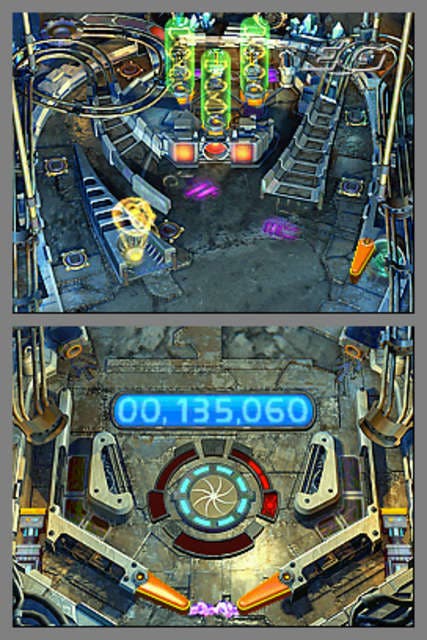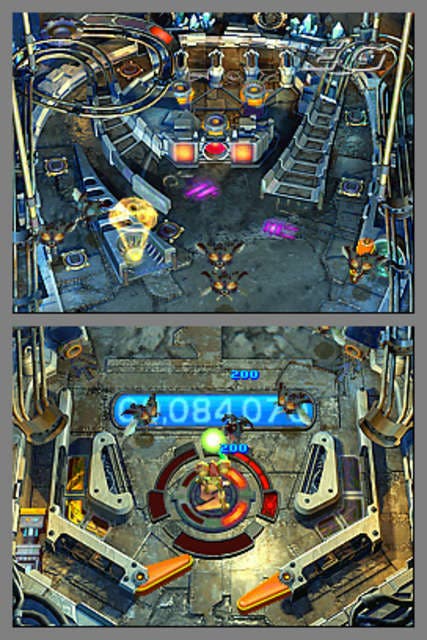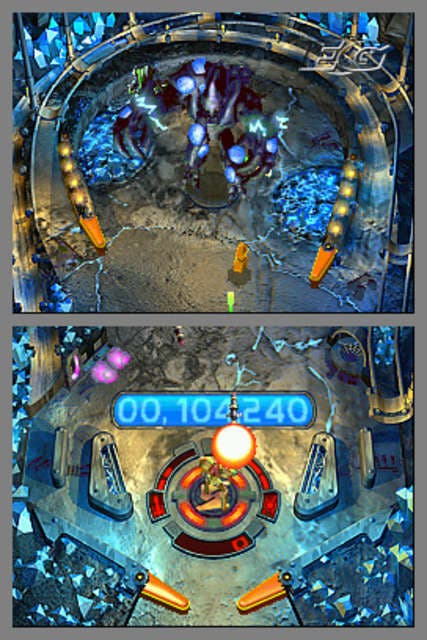Metroid Prime Pinball
Flipping hell.
The first thing you need to know about Metroid Prime Pinball is that it's bundled with a rumble pack. Nintendo, up to its old tricks again, has seen fit to launch a new accessory for a system by attaching it to a game, which works fine when it's the calibre of say, Lylat Wars (the N64's rumble pack bundle) but less so when it's a Donkey Kong 64 (the N64's memory expansion bundle).
All discussion of the quality of the game aside, the one good feature of the rumble pack bundled with Metroid Prime Pinball is that unlike the pack that came with Lylat Wars, it doesn't require batteries. Of course, the mere idea of it requiring batteries is ridiculous, but hey, I'm struggling for positives here. I could claim at least it's only the size of a GBA cart, but, oops, that means it'll still stick out of those DS Lites you're all eyeing up so lustfully. Even worse, the output from this so-called 'rumble' pack is so weak, and so ineffective, that the term 'a mouse's fart' comes to mind. Not only does the rumble pack offer a tremor comparable to the almost non-existent pressure a incontinent field mouse might exert upon your palm, it also has sounds like the aforementioned gastrointestinal agony. The manual helpfully states: "When Rumble Feature is on, the Rumble Pack will make sounds during game play."

It is, frankly, an embarrassing piece of kit, one that you'll rip out of the machine after a couple of minutes of mortification. Let's not speak of it again.
Allowing ourselves to discuss the quality of the game, let's just say it doesn't do as good a job as Lylat Wars did at washing away the sour taste of a useless peripheral.
Pinball sounds like the kind of thing it would be incredibly hard to mess up (after all, it's just two flippers and a ball, right?) but the subtleties of design available are many, and in general, Metroid Prime Pinball's innovations offer far less than solid table design would. In the first of three modes, Multi Mission, you take part in a campaign across six of the game's seven tables to collect artefacts. Single Mission mode allows you to choose a single table, from a choice of two initially, with four to unlock, and take part in ether a high score or time trial. Wireless Mission mode allows up to eight players to take part in a score race via download play using multiplayer-only table Magmoor Caverns.
Fitting the Metroid theme, the ball is Samus in Morph Ball mode, with the capability to drop up to three bombs at any one time. During the Multi Mission mode you are expected to find and unlock both missile and super bomb upgrades, and Samus - also uniquely for a pinball game - has a life bar.

Of the seven tables on offer, a mere three are traditional pinball tables, and with one of those multiplayer-only the majority of the time spent playing the Multi Mission focuses on the four tables on which you do battle with boss characters. Slamming the ball against them repeatedly is a largely unskilled and often frustrating affair, with your ball's life meter evaporating quickly from the bosses' unavoidable attacks.
At many points during the game it's actually fairly difficult to get the ball to roll out of bounds, as much like spiritual predecessor Pokemon Pinball: Ruby and Sapphire, which offered copious ball saves, here you often find an invincible barrier between the flippers. This means that for stretches of the game the main worry is the life bar, but it's easy to become irritated during the few moments the barrier disappears, as a Triclops, one of the many enemies that wanders the tables, usually catches and fires the ball directly between the flippers, inescapably.
Whither the tilt? In what the designers probably thought was a terribly immersive idea to bring across the desperation of the tilt function, you tilt by tapping the screen. Of course, you'll therefore never, ever have time to perform this when it counts, as it's far less intuitive than even pressing a button. I've only managed to save my ball using the tilt once, and that was pure luck. The game does manage to use the DS' two screens effectively, with the gap taken account of and not affecting gameplay, allowing the tables to be seen in full.

Some of the mini-games, particularly those in which Samus transforms back into human form for either a wall jumping marathon or a shooting match are quite fun, and they actually take up a significant portion of game time themselves. The fact is, this is a very poor pinball game, but taken as a homage to the Metroid series, it's an acceptable exercise - working your way through the Multi Mission with the that mindset can be a short, sometimes frustrating, but interesting trip through the locations of Metroid Prime, but sadly one that doesn't offer very much in the way of replayability.
It's bitter that the wireless play not only feels completely useless, with only the barest interaction between players, but that the table isn't available in any other mode. Indeed, only the two traditional pinball tables (Pirate Frigate and Tallon Overworld) are worth replaying, similar as they are to the two tables from Pokemon Pinball: Ruby and Sapphire. Without the gotta catch 'em all game mechanic, though, there's soon little impetus to soldier on with them.
Metroid Prime Pinball is a game that requires that you're a bigger fan of the 'Metroid Prime' part of the title than you are of the 'Pinball' part. While fun can be had here, it's from the mini-games and the experience rather than solid table designs - and that's a cardinal sin in pinball.

